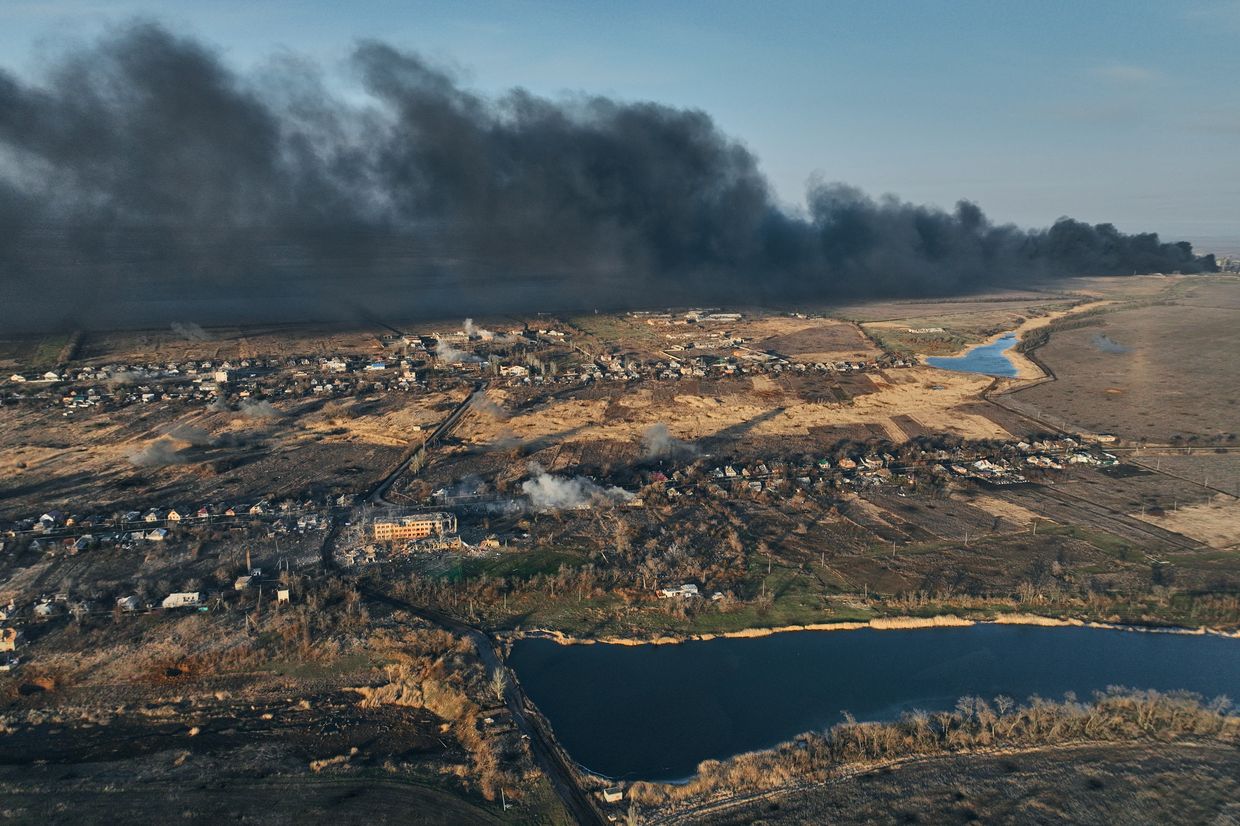Munich diaries: Fear and uncertainty at the ‘Lose-Lose’ conference

Editor’s note: The following piece is a personal account of the Munich Security Conference from a Kyiv Independent reporter but does not purport to reflect the views of the publication.
MUNICH – For three days every year, the space in front of the Bayerischer Hof Hotel in central Munich turns into one of the most locked-down security zones in the world.
By the entrance, brand new futuristic BMWs constantly ferried world leaders, ministers, generals, and other movers and shakers in and out of the world’s premier security event.
The view through the glass doors into the building, off limits for the press apart from a few exceptions, offers fleeting glimpses of a sea of suits, of important people and their stern-faced entourages, floating between small-talk interactions, sideline chats, and panel discussions.
This year’s Munich Security Conference, the 60th anniversary edition, came at one of the most fraught moments for international security in the post-war era.
Together with our videographer, with whom we had just been to the front line in Donbas two weeks earlier, we were sent to cover Ukraine’s struggle on a very different, diplomatic front.
The conference’s organizers were in no illusion about the darkness of the moment, with the slogan of “Lose-Lose?” adorning the front cover of their annual security report.
This phrase makes for dramatic, catchy wording for those in the safety of well-off Western capitals worried about how the one world order might slowly be replacing another.
The politicians and experts who came here may be genuinely concerned about negative trends and dark forces rising in the world. But the idea of their comfortable homes in Berlin, Paris, or Washington actually being under threat of attack or occupation remains very distant.
For Ukraine, the reality is the opposite. While the parade of diplomacy played out in and around the hotel in Munich, checking one’s phone opened a window into the deep, bitter hell that was unfolding in the small industrial city Avdiivka.
After standing firm in the fortress city for almost 10 years of Russia’s war, Ukraine’s hold on Avdiivka fell apart slowly, slowly, then all at once, with harrowing stories going viral on social media of the soldiers who made it out alive… and those who didn’t.
At 2 a.m. on the night before President Volodymyr Zelensky was due to speak at the conference, his newly-appointed Commander-in-Chief Oleksandr Syrskyi issued the order to withdraw.
Later that day, Zelensky didn’t mince his words. "If Ukraine is left alone, Russia will destroy us," he said on the main stage.
My conference started the day before, with a round-table discussion with Eurasia Group head Ian Bremmer, a veteran of the event and one of the most-respected minds in international affairs.
Bremmer pulled no punches when it came to setting the tone of the conference. Rightly so, he spoke of three major wars currently shaking the world… the first two being Ukraine and Gaza respectively.
Ukraine, he said, was going to be partitioned in two, as there was simply no feasible way for Ukrainian forces to regain the occupied territories by force.
Partitioned in two, but where? Frozen more or less along current lines, or sometime after a new Russian offensive on Kyiv?
I asked Bremmer what version of events the U.S. could make peace with, to which he replied that he thought a second attack on Kyiv was very unlikely, and that Donald Trump as president might even succeed in bringing Russia to the negotiating table.
Again, the distance between here and there could be felt. Sure, a new attack on Kyiv could seem a long way away or even impossible, but Avdiivka showed that without enough ammunition to repel Russian assaults or counters to their gliding bombs, Ukrainian forces could lose their ability to stay in the fight at all.
Bremmer’s third and last war was the internal war in the U.S., not just between Democrats and Republicans but between American democracy and the looming force of Trump trying to destroy it.
The spectre of Trump loomed over the conference; hardly surprising given his recent unhinged comments about encouraging an aggressor to attack NATO member states that hadn’t met the alliance’s defense spending quota.
Across panel discussions and in the mouths of many distinguished guests, the call to increase defense production and expand European armies could be heard across the board.
But within that dilemma was another, far more urgent one. If Europe must learn to protect itself without the U.S., will it and can it bring Ukraine into its umbrella and save it from being overwhelmed by Russia?
Here, there are objective facts that are impossible to ignore. One of the key pillars upon which Ukraine’s ability to stay in the fight stands is U.S. supplies of equipment, particularly 155mm shells, guided multiple-launch rockets, and air defense ammunition.
But, when it comes to shells especially, European countries simply can’t produce enough fast enough, so if they want to step up their help for Ukraine, the options are limited.
Some still hold on to hope that Germany will follow in the footsteps of the U.K. and France and provide long-range Taurus cruise missiles to Kyiv. As I found out when I asked Defense Minister Boris Pistorius though, apparently “there is no new logic, and the arguments haven’t changed.” When pressed on the issue, Chancellor Olaf Scholz deflected, pointing instead to Germany’s status as the largest spender on Ukraine aid in Europe.
To give the Germans the credit they deserve, Berlin did announce a new 1.1 billion euro aid package right before the conference, including crucial artillery and air defense ammunition. But with that clear sign of commitment, that just makes the Taurus decision — clearly a political one — all the more baffling.
Other countries are also making their own moves.
In what could be a life-saver for Kyiv, Czech President Petr Pavel announced that Prague had identified hundreds of thousands of shells outside the EU that could quickly be delivered to Ukraine if only the funding was secured. If only.
Meanwhile, the U.K., Latvia, and the Netherlands have moved to form a new drone coalition, to empower Ukraine with the innovation and production resources to get the tech edge over Russia. I’ve occasionally been given chances to watch the cat and mouse game of drone warfare play out for myself; if they do it properly, it could be huge.
I don’t think it was a coincidence that most of the leaders and ministers I managed to speak to were from the smaller, but more vocal European countries: Sweden, the Netherlands, Finland, and Lithuania.


These countries, in their own way, have all gone above and beyond the call of duty to advocate for more military aid.
Some, like the Netherlands with F-16s, have taken the lead with the provision of key weapons systems, breaking delusional taboos about escalation.
Looking these leaders eye-to-eye (whilst remembering George W. Bush’s lesson not to rely too much on that), I could feel that they cared, really.
But that didn’t stop some of them falling into the same traps: namely, avoiding the problems of the present by basking in the victories of the past; of a very different war.
“Of all the territory the Russians gained since Feb. 24 2022, a large part of that, you have recaptured,” Dutch Prime Minister Mark Rutte told me in our short conversation inside the hotel.

I certainly didn’t play any personal part in the Kharkiv and Kherson oblast counteroffensives back then, but I have spoken to soldiers who were there and are still fighting, now in the trenches outside Bakhmut. For them, those memories are from a different world entirely.
I have written before that one of the most important things in this war, for participants, observers, or leaders, is staying in touch with reality, however uncomfortable that is.
Here, the reality is a stark one: where it seemed over summer that the counteroffensive could still make a big breakthrough, it is Ukraine’s Armed Forces that are now under greater strain than at any time in the full-scale war.
Over autumn and winter, with Russia’s fierce retaking of the initiative, the military aid blocked in Congress, and Ukraine struggling to mobilize and supply the new soldiers it needs, the war has seen a major paradigm shift.
With the country’s fate hinging directly on the military’s capacity to fight, we now face a situation where Ukraine is not — for now, at least — fighting for victory, but for survival.
I wrote about this back in November, but world leaders have still been slow to publicly acknowledge it; even Zelensky’s strong language was unusual coming from a president known for his stubborn optimism.
Of all those I spoke to at the conference, one person nailed the problem as bluntly as anyone could: the young and charismatic Foreign Minister of Lithuania, Gabrielius Landsbergis.

“If Western allies, Ukrainian allies, do not wake up to this forming new reality, which is very dangerous for Ukraine and very dangerous for Europe… then we are all in trouble,” he said to me outside the hotel as the conference neared its close.
“If Putin is emboldened by his territorial gains in Ukraine to go further, the question remains, who can he attack next?”
By Monday morning, normal traffic returned to the streets of central Munich as the guests headed to their home countries, ready to act or not on the discussions held here.
For Ukraine, the tense wait for the House vote on military aid funding continues.
In the meantime, every shell and missile not delivered, every piece of support delayed or rejected, continues to come at the cost of Ukrainian lives. Let’s see where we will stand in a year’s time.

















